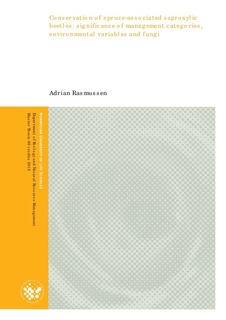| dc.description.abstract | Intensive modern forestry is a threat to beetles depending on dead wood (saproxylic beetles). To mitigate these negative effects, forests are regularly set aside as woodland key habitats or retention patches, as supplements to nature reserves. However, there are considerable uncertainties regarding the relative effectiveness of woodland key habitats and retention patches. In addition, it is important to know if these types of conservation are effective for organisms with different ecology and biology.
To explore these issues, the species richness, abundance and composition of spruce-associated saproxylic beetles was compared between 8 woodland key habitats, 9 retention patches and one nature reserve, in one production forest in Norway. Two types of flight intercept traps were used, which were placed on Norway spruce (Picea abies). Furthermore, I assessed if fungivores and cambium consumers of spruce-associated saproxylic beetles had similar responses to the management categories. Then I examined the relationship between the beetles and environmental variables. Lastly, it was tested for relationships between the species richness of saproxylic beetles and wood-decaying fungi found on the same logs as the traps.
My results were that woodland key habitats, but not retention patches, had a significantly different species richness of saproxylic beetles from the nature reserve. No significant differences were found in species abundance. Furthermore, no significant differences were found in species richness or abundance of fungivores and cambium consumers between the management categories. Also, dead-wood parameters and sun-exposure could not explain the variation in species richness. However, species composition differences between management categories were significant for saproxylic beetles, but not for fungivores or cambium consumers. Lastly, the species richness of fungi did neither correlate with the species richness of saproxylic beetles, nor with the different functional groups.
These results indicate that the conservation value of the woodland key habitats and the retention patches are useful supplements to the nature reserve, in terms of conserving spruce-associated saproxylic beetles in Selvik. Also, the correlation between spruce-associated saproxylic beetles and fungi appears to be weak on a relatively small temporal and spatial scale. However, it is unclear if the populations that were sampled in woodland key habitats and retention patches will be sustained over time, or if they will go extinct as a result of the relatively high degree of fragmentation in these management categories. | no_NO |
